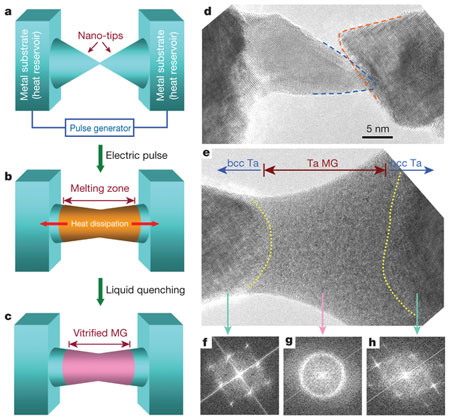| Posted: Aug 13, 2014 |
Engineer solves an age-old conundrum and turns metal into glass
|
|
(Nanowerk News) Materials scientists have long sought to form glass from pure, monoatomic metals. Scott X. Mao and colleagues did it.
|
|
Their paper, "Formation of monatomic metallic glasses through ultrafast liquid quenching", was recently published online in Nature, a leading science journal.
|
 |
| Illustration of an ultrafast liquid-quenching approach. (© Nature Publishing Group)
|
|
Mao, William, Kepler Whiteford Professor of Mechanical Engineering and Materials Science at the University of Pittsburgh, says, "This is a fundamental issue explored by people in this field for a long time, but nobody could solve the problem. People believed that it could be done, and now we're able to show that it is possible."
|
|
Metallic glasses are unique in that their structure is not crystalline (as it is in most metals), but rather is disordered, with the atoms randomly arranged. They are sought for various commercial applications because they are very strong and are easily processed.
|
|
Mao's novel method of creating metallic glass involved developing and implementing a new technique (a cooling nano-device under in-situ transmission electron microscope) that enabled him and his colleagues to achieve an unprecedentedly high cooling rate that allowed for the transformation of liquefied elemental metals tantalum and vanadium into glass.
|

